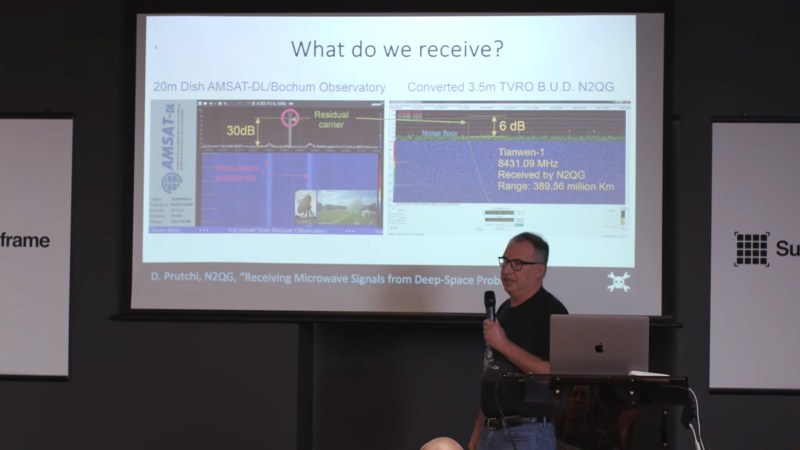
Here’s the thing about radio signals. There is wild and interesting stuff just getting beamed around all over the place. Phrased another way, there are beautiful signals everywhere for those with ears to listen. We go about our lives oblivious to most of them, but some dedicate their time to teasing out and capturing these transmissions.
David Prutchi is one such person. He’s a ham radio enthusiast that dabbles in receiving microwave signals sent from probes in deep space. What’s even better is that he came down to Supercon 2023 to tell us all about how it’s done!
Space Calling
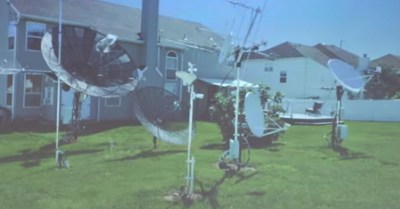
David notes that he’s not the only ham out there doing this. He celebrates the small community of passionate hams that specialize in capturing signals directly from far-off spacecraft. As one of these dedicated enthusiasts, he gives us a look at his backyard setup—full of multiple parabolic dishes for getting the best possible reception when it comes to signals sent from so far away. They’re a damn sight smaller than NASA’s deep space network (DSN) 70-meter dish antennas, but they can still do the job. He likens trying to find distant space signals as to “watching grass grow”—sitting in front of a monitor, waiting for a tiny little spike to show up on a spectrogram.
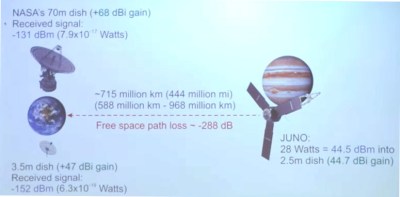
The challenge of receiving these signals comes down to simple numbers. David explains that a spacecraft like JUNO emits 28 watts into a 2.5-meter dish, which comes out to roughly 44.5 dBm of signal with a 44.7 dBi gain antenna. The problem is one of distance—it sits at around 715 million kilometers away on its mission to visit Jupiter. That comes with a path loss of around -288 dB. NASA’s 70-meter dish gets them 68 dBi gain on the receive side, which gets them a received signal strength around -131 dBm. To transmit in return, they transmit around the 50-60 kW range using the same antenna. David’s setup is altogether more humble, with a 3.5-meter dish getting him 47 dBi gain. His received signal strength is much lower, around -152 dBm.
His equipment limits what he can actually get from these distant spacecraft. National space agencies can get full signal from their dishes in the tens-of-meters in diameter, sidebands and all. His smaller setup is often just enough to get some of the residual carrier showing up in the spectrogram. Given he’s not getting full signal, how does he know what he’s receiving is the real deal? It comes down to checking the doppler shift in the spectrogram, which is readily apparent for spacecraft signals. He also references the movie Contact, noting that the techniques in that film were valid. If you move your antenna to point away from the suspected spacecraft, the signal should go away. If it doesn’t, it might be that you’re picking up local interference instead.
THIS. IS. JUST. AWESOME. !!!
This is video decoded from the 8455MHz high rate downlink @uhf_satcom received yesterday. All the work on the decoder and data analysis really paid off in the end!
Video shows solar panel of Chang’e-5 glistening in the sun and dust floating around. pic.twitter.com/FKc92kgskl
— r00t (@r2x0t) November 25, 2020
Some hobbyists have been able to decode video feeds from spacecraft downlinks.
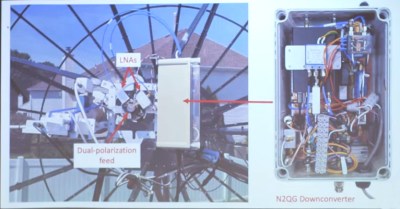
However, demodulating and decoding full spacecraft signals at home is sometimes possible—generally when the spacecraft are still close to Earth. Some hobbyists have been able to decode telemetry from various missions, and even video signals from some craft! David shows some examples, noting that SpaceX has since started encrypting its feeds after hobbyists first started decoding them.
David also highlights the communications bands most typically used for deep space communication, and explains how to listen in on them. Most of it goes on in the S-band and X-band frequencies, with long-range activity focused on the higher bands.
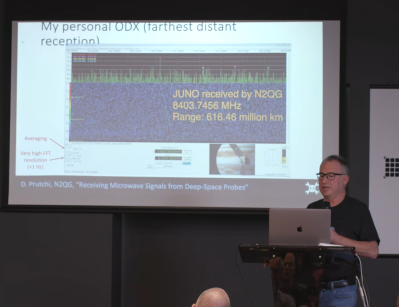
Basically, if you want to get involved in this kind of thing, you’re going to want a dish and some kind of software defined radio. If you’re listening in S-band, that’s possibly enough, but if you’re stepping up into X-band, you’ll want a downconverter to step that signal down to a lower frequency range, mounted as close to your dish as possible. This is important as X-band signals get attenuated very quickly in even short cable runs. It’s also generally required to lock your downconverter and radio receiver to some kind of atomic clock source to keep them stable. You’ll also want an antenna rotator to point your dishes accurately, based on data you can source from NASA JPL. As for finding downlink frequencies, he suggests looking at the ITU or the Australian Communication and Media Authority website.
He also covers the techniques of optimizing your setup. He dives into the minutae of pointing antennas at the Sun and Moon to pick up their characteristic noise for calibration purposes. It’s a great way to determine the performance of your antenna and supporting setup. Alternatively, you can use signals from geostationary military satellites to determine how much signal you’re getting—or losing—from your equipment.
Ultimately, if you’ve ever dreamed of listening to distant spacecraft, David’s talk is a great place to start. It’s a primer on the equipment and techniques you need to get started, and he also makes it sound really fun, to boot. It’s high-tech hamming at its best, and there’s more to listen to out there than ever—so get stuck in!
